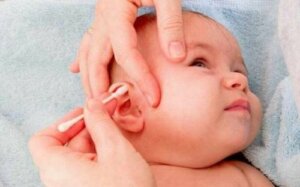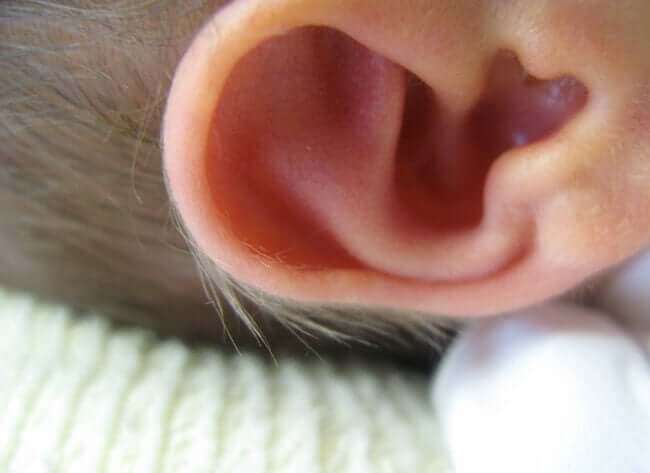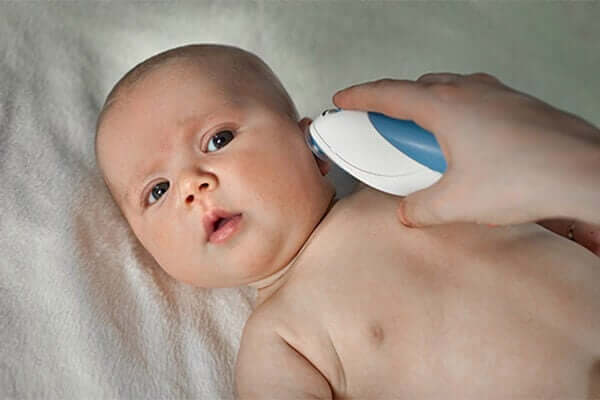Why Shouldn't You Use Cotton Swabs to Clean Your Baby's Ears?


Reviewed and approved by the doctor Nelton Ramos
Cotton swabs aren’t the most recommended objects to use in order to clean your baby’s ears. And although many claim that the problem isn’t the swabs themselves but their misuse that can cause damage, excessive cleaning can cause wax and particles to be pushed into the inner ear rather than removing them.
If you knew more about the delicacy of the ears, you wouldn’t clean them with such enthusiasm in children or in yourself. The wax produced in the outer part of the ear has as its main function to protect the ear canal and eardrum.
In this way, the wax, as a natural defensive system, prevents dirt, germs, and even insects from getting inside. Also, when you completely remove the natural wax from your child’s ear at home, you actually cause more wax to be produced.
This happens because you’re stimulating the ceruminous glands responsible for its production. The truth is that most of us don’t know how to use cotton swabs, which can even leave traces of cotton in the ear canal without us even noticing it.
Use cotton swabs with care

A recent update to the recommendations of the American Academy of Otolaryngology warns of the injuries these swabs can cause in children. These range from small dislocations in the fine bones of the ear to cuts, erosions of the skin, and, in the worst cases, perforation of the eardrum.
It’s proven that the rate of patients with recurrent infections is much higher among those who use cotton swabs. In fact, every ear, nose, and throat doctor has seen on occasion dislocations of the ossicles of the middle ear and also, more extreme cases, such as children who’ve put these sticks in their ears in order to imitate their parents.
You shouldn’t introduce anything smaller than an adult finger into your child’s ear. In other words, nothing that passes into the ear canal. Nor should you use substances such as oil, hydrogen peroxide, or aerosols.
Ear cleaning
To clean children’s ears, a bath with a little warm water and soap will suffice. You must delicately clean the pavilion with a finger, and above all, rinse and dry the area well because otherwise there may be traces of soap that will cause eczema.
Infections in children caused by improper cleaning can lead to otitis which, in addition to being a painful process for them, is long-term and recurrently related to reduced hearing or loss of hearing.
Otitis media is a condition that only requires antibiotic treatment in extreme cases. It usually appears as the result of a flu process that has attacked the upper respiratory tract and fever is the body’s mechanism to defend itself as a natural process. It’s actually a tough process for the child.
If you ever find yourself dealing with this type of infection and the baby has a fever, in order to release the heat and lower their temperature, place warm water compresses with lemon on their arms and legs or by wrapping the child in a cloth soaked in warm water (not too hot).
The heat of fever produces a lot of dilation of the blood vessels and lemon is a vasoconstrictor and anti-inflammatory agent. You can also relieve ear pain with hot bags of onion or chamomile flowers, attached to the ear.
Acute otitis media infections are self-limited and heal on their own. However, you should visit a doctor when they become complicated or if the child is under two years of age. It’s best to differentiate between viral infections, which are untreatable, and bacterial infections, which we can treat.
You should always practice extreme precaution when it comes to children under two years of age and when the otitis is recurrent, with a frequency of five episodes a year or three in half a year. To avoid long-term problems, go to the specialist, who will perform a culture to check which microorganism is causing the infection.
Tips for caring for your baby’s ears

- Control the symptoms of excess wax. These are hearing loss, a sensation of fluid overflowing in the ear, tinnitus or ringing, and distorted sounds.
- You should go to the specialist if the child has undefined pain in the ear not related to a catarrhal process, as an external or media otitis can actually mask excess earwax.
What not to do?
- No object smaller than a finger should be inserted.
- Under no circumstances should candles be used to clean the ears, or drops, or any other type of saline solution.
- Don’t ignore or underestimate any symptoms or any discomfort that your child presents. It’s preferable to go to a specialist’s office early for an evaluation and early diagnosis than to wait for the lesions to worsen before starting treatment.
In conclusion, excessively cleaning the ears, both of children and of any person, is counterproductive because it leaves the way completely free for insects, germs, and other agents to the interior of the ear canal. It’s important to maintain a balance when it comes to hygiene and, when in doubt, consult your doctor.
Cotton swabs aren’t the most recommended objects to use in order to clean your baby’s ears. And although many claim that the problem isn’t the swabs themselves but their misuse that can cause damage, excessive cleaning can cause wax and particles to be pushed into the inner ear rather than removing them.
If you knew more about the delicacy of the ears, you wouldn’t clean them with such enthusiasm in children or in yourself. The wax produced in the outer part of the ear has as its main function to protect the ear canal and eardrum.
In this way, the wax, as a natural defensive system, prevents dirt, germs, and even insects from getting inside. Also, when you completely remove the natural wax from your child’s ear at home, you actually cause more wax to be produced.
This happens because you’re stimulating the ceruminous glands responsible for its production. The truth is that most of us don’t know how to use cotton swabs, which can even leave traces of cotton in the ear canal without us even noticing it.
Use cotton swabs with care

A recent update to the recommendations of the American Academy of Otolaryngology warns of the injuries these swabs can cause in children. These range from small dislocations in the fine bones of the ear to cuts, erosions of the skin, and, in the worst cases, perforation of the eardrum.
It’s proven that the rate of patients with recurrent infections is much higher among those who use cotton swabs. In fact, every ear, nose, and throat doctor has seen on occasion dislocations of the ossicles of the middle ear and also, more extreme cases, such as children who’ve put these sticks in their ears in order to imitate their parents.
You shouldn’t introduce anything smaller than an adult finger into your child’s ear. In other words, nothing that passes into the ear canal. Nor should you use substances such as oil, hydrogen peroxide, or aerosols.
Ear cleaning
To clean children’s ears, a bath with a little warm water and soap will suffice. You must delicately clean the pavilion with a finger, and above all, rinse and dry the area well because otherwise there may be traces of soap that will cause eczema.
Infections in children caused by improper cleaning can lead to otitis which, in addition to being a painful process for them, is long-term and recurrently related to reduced hearing or loss of hearing.
Otitis media is a condition that only requires antibiotic treatment in extreme cases. It usually appears as the result of a flu process that has attacked the upper respiratory tract and fever is the body’s mechanism to defend itself as a natural process. It’s actually a tough process for the child.
If you ever find yourself dealing with this type of infection and the baby has a fever, in order to release the heat and lower their temperature, place warm water compresses with lemon on their arms and legs or by wrapping the child in a cloth soaked in warm water (not too hot).
The heat of fever produces a lot of dilation of the blood vessels and lemon is a vasoconstrictor and anti-inflammatory agent. You can also relieve ear pain with hot bags of onion or chamomile flowers, attached to the ear.
Acute otitis media infections are self-limited and heal on their own. However, you should visit a doctor when they become complicated or if the child is under two years of age. It’s best to differentiate between viral infections, which are untreatable, and bacterial infections, which we can treat.
You should always practice extreme precaution when it comes to children under two years of age and when the otitis is recurrent, with a frequency of five episodes a year or three in half a year. To avoid long-term problems, go to the specialist, who will perform a culture to check which microorganism is causing the infection.
Tips for caring for your baby’s ears

- Control the symptoms of excess wax. These are hearing loss, a sensation of fluid overflowing in the ear, tinnitus or ringing, and distorted sounds.
- You should go to the specialist if the child has undefined pain in the ear not related to a catarrhal process, as an external or media otitis can actually mask excess earwax.
What not to do?
- No object smaller than a finger should be inserted.
- Under no circumstances should candles be used to clean the ears, or drops, or any other type of saline solution.
- Don’t ignore or underestimate any symptoms or any discomfort that your child presents. It’s preferable to go to a specialist’s office early for an evaluation and early diagnosis than to wait for the lesions to worsen before starting treatment.
In conclusion, excessively cleaning the ears, both of children and of any person, is counterproductive because it leaves the way completely free for insects, germs, and other agents to the interior of the ear canal. It’s important to maintain a balance when it comes to hygiene and, when in doubt, consult your doctor.
All cited sources were thoroughly reviewed by our team to ensure their quality, reliability, currency, and validity. The bibliography of this article was considered reliable and of academic or scientific accuracy.
- ¿Cuál es la mejor manera de limpiar nuestros oídos? BBC Mundo – Programa: ”Confía en mí, soy doctor”. 2015. [En línea].
- Schwartz, S. R., Magit, A. E., Rosenfeld, R. M., Ballachanda, B. B., Hackell, J. M., Krouse, H. J., … Cunningham, E. R. (2017). Clinical Practice Guideline (Update): Earwax (Cerumen Impaction). Otolaryngology–Head and Neck Surgery : Official Journal of American Academy of Otolaryngology-Head and Neck Surgery, 156(1_suppl), S1–S29. https://doi.org/10.1177/0194599816671491
- González Compta, X., & Navarro, J. M. (2009). Paso a paso: Lavado del oído. AMF (Vol. 5). Retrieved from http://amf-semfyc.com/upload_articles_pdf/Lavado_de_oido.pdf
- Tapones de cera, cerumen impactado, limpieza de oídos. (n.d.). https://www.clinicaotorrino.es/informacion-pacientes-patologias/patologia-general-orl/tapones-de-cera/
This text is provided for informational purposes only and does not replace consultation with a professional. If in doubt, consult your specialist.








